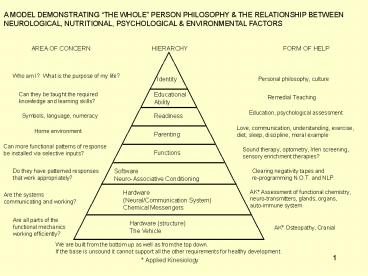Identity - PowerPoint PPT Presentation
1 / 10
Title:
Identity
Description:
We are built from the bottom up as well as from the top down. If the base is unsound it cannot support all the other requirements for healthy ... Neurology ... – PowerPoint PPT presentation
Number of Views:25
Avg rating:3.0/5.0
Title: Identity
1
A MODEL DEMONSTRATING THE WHOLE PERSON
PHILOSOPHY THE RELATIONSHIP BETWEEN
NEUROLOGICAL, NUTRITIONAL, PSYCHOLOGICAL
ENVIRONMENTAL FACTORS
Who am I? What is the purpose of my life?
Identity
Personal philosophy, culture
EducationalAbility
Can they be taught the required knowledge and
learning skills?
Remedial Teaching
Education, psychological assessment
Readiness
Symbols, language, numeracy
Love, communication, understanding, exercise,
diet, sleep, discipline, moral example
Home environment
Parenting
Can more functional patterns of responsebe
installed via selective inputs?
Sound therapy, optometry, Irlen screening,
sensory enrichment therapies?
Functions
SoftwareNeuro-Associative Conditioning
Do they have patterned responsesthat work
appropriately?
Clearing negativity tapes and re-programming
N.O.T. and NLP.
AK Assessment of functional chemistry,
neuro-transmitters, glands, organs, auto-immune
system
Hardware(Neural/Communication System)Chemical
Messengers
Are the systems communicating and working?
Are all parts of thefunctional mechanics
working efficiently?
Hardware (structure)The Vehicle
AK Osteopathy, Cranial
We are built from the bottom up as well as from
the top down. If the base is unsound it cannot
support all the other requirements for healthy
development.
Applied Kinesiology
2
THE TRIAD OF HEALTH and related therapeutic
approaches
3
SUNFLOWER THERAPY STAGES OF ASSESSMENT AND
TREATMENT
- 1. Provisional consultation, assessment and
report - 2. Structure
- To assess and treat the muscular skeletal system
so that patients can lie, sit, stand and walk
normally. - Neurology
- a) To evaluate about 200 reflexes which relate
to finer co-ordination and balance and also
those reflexes which relate to information
input, storage and retrieval. - b) Clearing negative neuro associations to
remove habitual negative patterns of responses
which block the childs ability to learn.
4
- 4. Nutritional Evaluation and Prescriptions
- To test for
- neuro-transmitter activity
- the balance of glands and organs
- liver detoxification pathways
- respiratory system
- auto-immune system
- gastro-intestinal tract
- inflammatory pathways
- allergies
- other systems
- and treat through diet, supplements and
homeopathy.
5
5. Psychological Reconditioning Neuro
Linguistic Programming (NLP) is used to assist
the child in establishing a positive attitude and
approach. It gives the child more
self-confidence and the ability to more readily
access the resources they have for dealing with
challenges successfully.
6
SUMMARY OF FINDINGS OF INITIAL RESEARCH
IQ Units
This graph shows the difference obtained in three
IQ tests, after treatment, between the treatment
and Non-Treatment groups
7
WHAT PARENTS HAVE SAID
- Has your child improved?YES (43 of 44) 98
- Is your child more relaxed, calm, co-operative
and enthusiastic?YES (40 of 44) 90 - Has your child been more successful at
school?YES (38 of 44) 86 - Has he/she won any awards forimproved
performance?YES (14 of 44) 34 - Did you feel it was money well spent?YES (42 of
44) 95 - Would you recommend the treatment to other
parents?YES (42 of 44) 95
- greater confidence - has changed
- the familys life - inner fear removed
- - greater responsibility - greater
- concentration - healthier - more
- positive - less tension - determined -
- very much improved - happier - less
- moodiness - happier at school -
- keen - physical improvement -
- academic improvement - mature -
- sensitive - focused - relaxed - trying
- to control junk food - willing to
- try new things
8
Sunflower Trust Graduates and Trainers 2003
9
LATEST STUDY
During the years 1999 - 2002 The Sunflower Trust
in conjunction with the Roehampton Institute
London (part of Surrey University), co-sponsored
a three-year PhD research project on the
Sunflower Therapy. Unfortunately the researcher
in question did not complete the work and
disappeared with much of the research data and it
would appear, with some of the post assessment
sheets of clinical data. Fortunately the Pre
and Post Sunflower screen data of 61 dyslexic
children has survived and it is part of this I
would like to present to you today.
10
OBJECTIVES OF STUDY
1. To discover if there are elements of
impaired efficiency in the many
different areas of function controlled by the
nervous system.2. To determine if it is
possible to improve these areas of function via
natural medicine.3. To establish
if improvements in such functions are associated
with comparative improvements in their
learning abilities, health, behaviour
and performance.Significant improvements in
quantitative and qualitative recorded scores
measured during the course of the research would
in our view, provide good clinical evidence for
the value of the Sunflower Therapy. The
Sunflower method is not a substitute for special
needs teaching for dyslexic children but
complementary to it.































